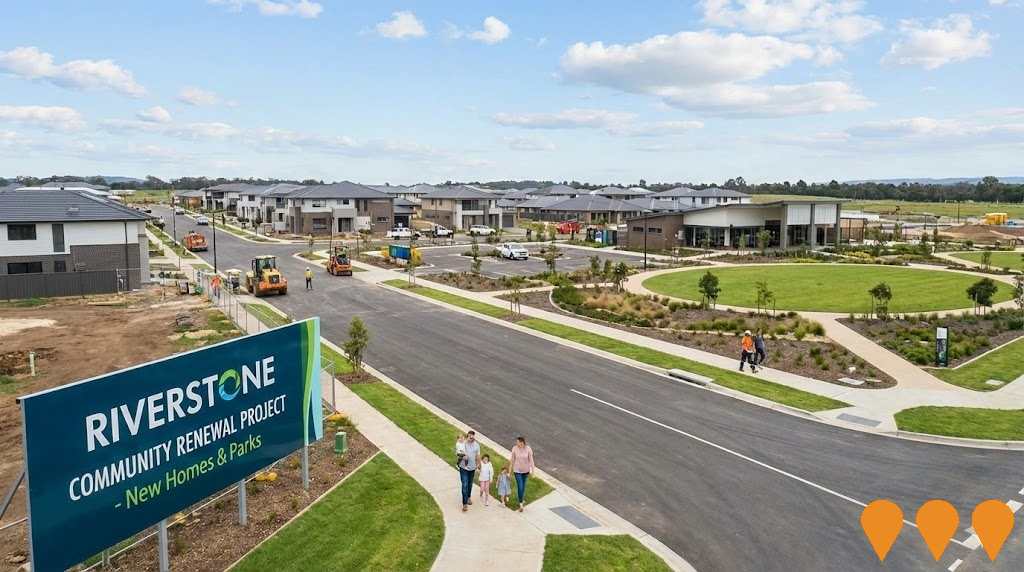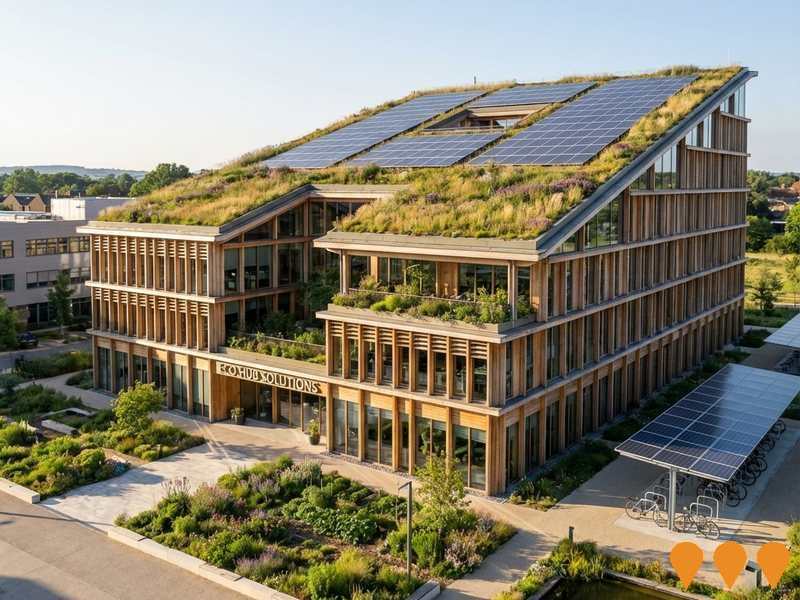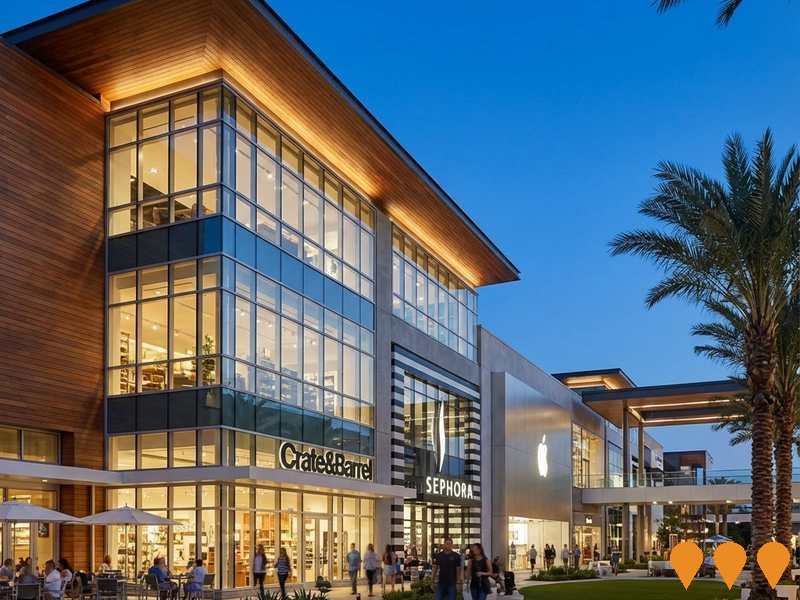Chart Color Schemes
est. as @ -- *
ABS ERP | -- people | --
2021 Census | -- people
Sales Activity
Curious about local property values? Filter the chart to assess the volume and appreciation (including resales) trends and regional comparisons, or scroll to the map below view this information at an individual property level.
Find a Recent Sale
Sales Detail
Population
Jordan Springs - Llandilo lies within the top quartile of areas nationally for population growth performance according to AreaSearch analysis of recent, and medium to long-term trends
Jordan Springs - Llandilo's population was around 15,576 as of August 2025. This figure reflects an increase of 2,188 people since the 2021 Census, which reported a population of 13,388. The change is inferred from the estimated resident population of 15,286 in June 2024 and an additional 177 validated new addresses since the Census date. This results in a density ratio of 688 persons per square kilometer, similar to averages seen across locations assessed by AreaSearch. The area's growth rate of 16.3% since the 2021 census exceeded the SA4 region (5.3%) and the state, making it a growth leader in the region. Natural growth contributed approximately 43.3% of overall population gains during recent periods, with all drivers including interstate migration and overseas migration being positive factors.
AreaSearch is adopting ABS/Geoscience Australia projections for each SA2 area, released in 2024 with 2022 as the base year. For areas not covered by this data, AreaSearch utilises NSW State Government's SA2 level projections released in 2022 with 2021 as the base year. Growth rates by age group are applied to all areas for years 2032 to 2041. Future population trends project an above median growth, with the area expected to expand by 2,270 persons to 2041 based on latest numbers, indicating a total increase of 12.7% over the 17-year period.
Frequently Asked Questions - Population
Development
AreaSearch assessment of residential approval activity sees Jordan Springs - Llandilo among the top 30% of areas assessed nationwide
Jordan Springs - Llandilo has seen approximately 95 dwelling approvals annually over the past five financial years, totalling 476 homes. As of FY26, nine approvals have been recorded. On average, 8.5 new residents per year arrive per dwelling constructed between FY21 and FY25. This supply lagging demand indicates heightened buyer competition and pricing pressures; new homes are being built at an average cost of $504,000.
In FY26, there have been $9.6 million in commercial approvals, showing moderate commercial development levels compared to Greater Sydney. Jordan Springs - Llandilo has slightly more development than the regional average per person over the past five years. Recent construction comprises 32% standalone homes and 68% townhouses or apartments, a shift from the area's current housing composition of 91% houses. This trend reflects decreasing developable sites and changing lifestyles preferences for diverse, affordable housing options. The estimated population per dwelling approval is 832 people, reflecting its quiet development environment.
Future projections indicate Jordan Springs - Llandilo adding 1,980 residents by 2041, with current construction levels expected to meet demand adequately, creating favourable buying conditions and potential growth exceeding forecasts.
Frequently Asked Questions - Development
Infrastructure
Jordan Springs - Llandilo has very high levels of nearby infrastructure activity, ranking in the top 20% nationally
Changes to local infrastructure significantly impact an area's performance. AreaSearch has identified 29 projects that may affect the region. Notable ones include Emerald Grove Jordan Springs, New High School for Jordan Springs, Jordan Springs East Remediation, and Ropes Crossing Estate - Remaining Stages (Final Residential Lots). The following list details those most likely to be relevant.
Professional plan users can use the search below to filter and access additional projects.
INFRASTRUCTURE SEARCH
 Denotes AI-based impression for illustrative purposes only, not to be taken as definitive under any circumstances. Please follow links and conduct other investigations from the project's source for actual imagery. Developers and project owners wishing us to use original imagery please Contact Us and we will do so.
Denotes AI-based impression for illustrative purposes only, not to be taken as definitive under any circumstances. Please follow links and conduct other investigations from the project's source for actual imagery. Developers and project owners wishing us to use original imagery please Contact Us and we will do so.
Frequently Asked Questions - Infrastructure
Box Hill Release Area Development
Major greenfield release area in north west Sydney planned under the NSW Government North West Priority Growth Area program. The Box Hill and Box Hill Industrial precincts are intended to deliver around 9600 new homes, a town centre, schools, employment land and supporting open space, transport and utility infrastructure. Development is being delivered progressively by private developers under planning controls set by the NSW Government and The Hills Shire Council, with ongoing subdivision, road upgrades and community facilities expected through the 2030s.

Nepean Hospital Redevelopment
A $1 billion redevelopment of Nepean Hospital including a new 14-storey hospital tower, expanding capacity for Western Sydney's growing population and creating thousands of jobs.

Ropes Crossing Village Shopping Centre Mixed-Use Redevelopment
Redevelopment of the Ropes Crossing Village Shopping Centre, a neighbourhood retail hub anchored by Coles. The approved, two-stage mixed-use development includes the expansion of the Coles supermarket, additional specialty retail and commercial suites, expanded parking, and the construction of 128 residential units across three 6-storey buildings.

Stockland The Gables Masterplanned Community
Large scale masterplanned community in the Hills Shire delivering around 4,100 homes across more than 300 hectares, with a mix of lot sizes, parks, walkways and a central lake. The project was initiated by Celestino and is now being delivered by Stockland, with multiple neighbourhoods, a K 12 Catholic school and significant open space. A new Stockland Gables town centre anchored by a full line Woolworths supermarket and about 30 specialty retailers opened in 2025, alongside medical, childcare and dining offers. Residential construction, community facilities and the Halcyon Gables land lease community are progressing, with overall estate build out expected to run through the second half of the 2020s.

Nepean Business Park
Transformation of a 47ha degraded former quarry site into a productive business park, providing local jobs while protecting and enhancing the environment, located 2km from Penrith CBD.

The Gables Sports Precinct
Top-grade sports precinct approved by The Hills Shire Council featuring premium hockey facility, amenities building, multi-purpose field and courts (basketball, netball, tennis, futsal), skate park zone, fitness zone and dog park. Designed to become the social hub of The Gables community.

New High School for Jordan Springs
The new high school for Jordan Springs is scheduled to open on Day 1, Term 1, 2027, initially for Year 7 and 8 students, expanding annually to a full Year 7-12 cohort by 2031. It will accommodate at least 1,000 students with modern classrooms, support spaces, library, administration facilities, specialist workshops for science, wood and metal work, covered outdoor learning area, canteen, multipurpose hall for sports and performances, sports courts, playing field, and landscaping. The design connects to Wianamatta Regional Park and includes provisions for future expansion. Principal to be appointed late 2025.
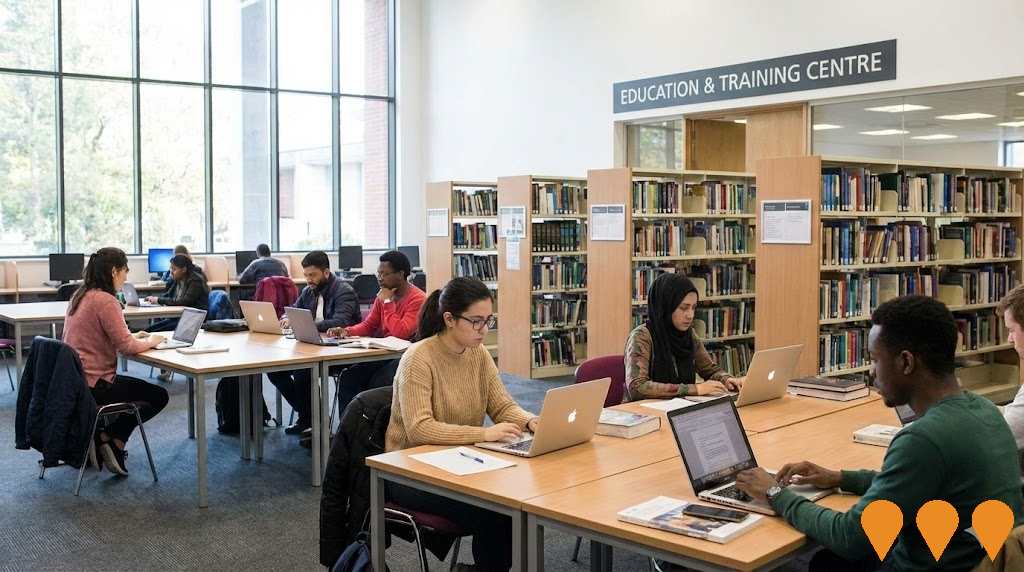
Village Park Jordan Springs
A circa 1.2 ha community park at the Jordan Springs Village Centre providing a community activation shelter with kitchen, BBQs, toilets and stage, a kick-about lawn, tiered amphitheatre, bio-retention / rain garden and landscaping upgrades.
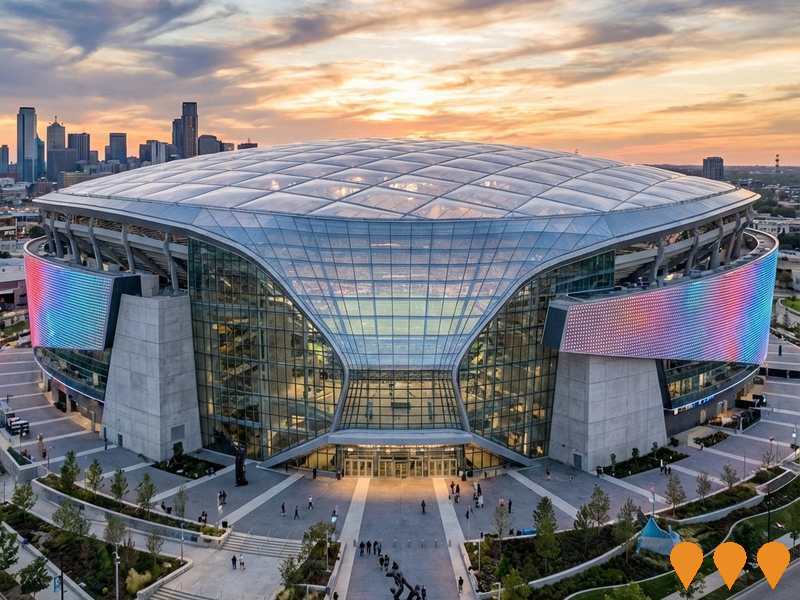
Employment
AreaSearch analysis of employment trends sees Jordan Springs - Llandilo performing better than 85% of local markets assessed across Australia
Jordan Springs-Llandilo has an educated workforce with prominent representation in essential services sectors, and a low unemployment rate of 1.9% as of June 2025. In this month, 8687 residents are employed while the unemployment rate is 2.3 percentage points lower than Greater Sydney's rate of 4.2%.
The workforce participation rate is high at 73.7%, compared to Greater Sydney's 60.0%. Key employment sectors among residents include healthcare and social assistance, construction, and retail trade. Notably, construction employment is high at 1.3 times the regional average. However, professional and technical services are under-represented, with only 5.9% of Jordan Springs-Llandilo's workforce compared to Greater Sydney's 11.5%.
Local employment opportunities appear limited, as indicated by the difference between Census working population and resident population figures. Between June 2024 and June 2025, the labour force decreased by 2.3%, while employment declined by 2.4%, leading to a rise in unemployment rate of 0.1 percentage points. In contrast, Greater Sydney saw employment growth of 2.6% and labour force growth of 2.9%, with an unemployment rate increase of 0.3 percentage points. Jobs and Skills Australia's national employment forecasts from May 2025 project a 6.6% increase in employment over five years and 13.7% over ten years. Applying these projections to Jordan Springs-Llandilo's employment mix suggests local growth of approximately 6.5% over five years and 13.4% over ten years, though these are simple weighted extrapolations for illustrative purposes only and do not account for localized population projections.
Frequently Asked Questions - Employment
Income
The economic profile demonstrates exceptional strength, placing the area among the top 10% nationally based on comprehensive AreaSearch income analysis
Jordan Springs - Llandilo had a median taxpayer income of $67,192 and an average of $75,871 in financial year 2022, according to postcode level ATO data aggregated by AreaSearch. This is above the national average, contrasting with Greater Sydney's median income of $56,994 and average income of $80,856. By September 2025, estimates suggest a median income of approximately $75,665 and an average of $85,438, based on Wage Price Index growth of 12.61% since financial year 2022. The 2021 Census figures show household, family, and personal incomes in Jordan Springs - Llandilo ranked between the 83rd and 89th percentiles nationally. Income analysis reveals that 42.0% of locals (6,541 people) earn between $1,500 and $2,999 per week, similar to the surrounding region where 30.9% fall within this range. The locality shows affluence with 34.8% earning over $3,000 per week. High housing costs consume 20.6% of income, but strong earnings place disposable income at the 83rd percentile nationally. The area's SEIFA income ranking places it in the 8th decile.
Frequently Asked Questions - Income
Housing
Jordan Springs - Llandilo is characterized by a predominantly suburban housing profile, with a higher proportion of rental properties than the broader region
Jordan Springs - Llandilo's dwelling structure, as per the latest Census, consisted of 91.3% houses and 8.7% other dwellings (semi-detached, apartments, 'other' dwellings). This compares to Sydney metro's 77.4% houses and 22.6% other dwellings. Home ownership in Jordan Springs - Llandilo stood at 12.4%, with the rest being mortgaged (54.1%) or rented (33.6%). The median monthly mortgage repayment was $2,600, higher than Sydney metro's average of $2,167. Median weekly rent in Jordan Springs - Llandilo was $530, compared to Sydney metro's $400. Nationally, mortgage repayments were significantly higher at $1,863 and rents substantially above the national figure of $375.
Frequently Asked Questions - Housing
Household Composition
Jordan Springs - Llandilo features high concentrations of family households, with a higher-than-average median household size
Family households constitute 87.0% of all households, including 54.2% couples with children, 20.4% couples without children, and 11.2% single parent families. Non-family households account for the remaining 13.0%, with lone person households at 11.0% and group households comprising 2.1%. The median household size is 3.3 people, larger than the Greater Sydney average of 2.8.
Frequently Asked Questions - Households
Local Schools & Education
Educational attainment in Jordan Springs - Llandilo aligns closely with national averages, showing typical qualification patterns and performance metrics
In Jordan Springs - Llandilo, as of the latest available data, 29.1% of residents aged 15 and above hold university degrees, compared to Greater Sydney's 38.0%. This indicates potential for educational development. Bachelor degrees are most common at 19.1%, followed by postgraduate qualifications (8.2%) and graduate diplomas (1.8%). Vocational credentials are also prominent, with 34.8% of residents aged 15 and above holding them, including advanced diplomas (12.0%) and certificates (22.8%).
Educational participation is high, with 32.5% of residents currently enrolled in formal education, broken down into primary (13.2%), secondary (7.4%), and tertiary (4.2%) levels. The three schools in Jordan Springs - Llandilo have a combined enrollment of 2,490 students, serving distinct age groups with balanced educational opportunities, as indicated by an ICSEA score of 994.
Frequently Asked Questions - Education
Schools Detail
Nearby Services & Amenities
Transport
Transport servicing is low compared to other areas nationally based on assessment of service frequency, route connectivity and accessibility
The analysis shows 57 active public transport stops operating within Jordan Springs - Llandilo. These are served by a mix of buses on 48 individual routes, providing a total of 562 weekly passenger trips. The accessibility is rated good, with residents typically located 202 meters from the nearest stop.
On average, there are 80 trips per day across all routes, equating to approximately 9 weekly trips per individual stop.
Frequently Asked Questions - Transport
Transport Stops Detail
Health
Jordan Springs - Llandilo's residents boast exceedingly positive health performance metrics with common health conditions somewhat prevalent across both younger and older age cohorts
Health outcomes data shows notable results across Jordan Springs-Llandilo. Common health conditions are somewhat prevalent among both younger and older age groups.
The rate of private health cover is very high at approximately 57% of the total population (around 8,893 people), compared to 53.8% in Greater Sydney. The most common medical conditions are asthma and mental health issues, affecting 7.1 and 6.6% of residents respectively, while 78.0% report being completely free from medical ailments, compared to 69.5% in Greater Sydney. As of 2021, 7.7% of residents are aged 65 and over (around 1,202 people), which is lower than the 14.1% in Greater Sydney. Health outcomes among seniors require more attention than those in the broader population.
Frequently Asked Questions - Health
Cultural Diversity
Jordan Springs - Llandilo was found to be more culturally diverse than the vast majority of local markets in Australia, upon assessment of a range of language and cultural background related metrics
Jordan Springs-Llandilo has a higher cultural diversity than most local areas, with 31.2% of its population born overseas and 32.5% speaking a language other than English at home. The dominant religion is Christianity, which accounts for 50.6% of the population. Hinduism is notably overrepresented, comprising 10.9%, compared to the Greater Sydney average of 3.6%.
In terms of ancestry, Australian is the largest group at 22.9%, followed by English at 18.8%, which is lower than the regional average of 24.2%. Other ancestry makes up 12.8% of the population. Some ethnic groups are notably overrepresented: Maltese at 4.7% (regional average 2.9%), Filipino at 5.0% (regional average 2.1%), and Indian at 8.9% (regional average 3.0%).
Frequently Asked Questions - Diversity
Age
Jordan Springs - Llandilo hosts a very young demographic, ranking in the bottom 10% of areas nationwide
Jordan Springs - Llandilo's median age is 32 years, which is younger than Greater Sydney's average of 37 years and significantly lower than Australia's national average of 38 years. Compared to Greater Sydney, Jordan Springs - Llandilo has a higher concentration of residents aged 5-14 (17.8%) but fewer residents aged 55-64 (6.1%). This concentration is well above the national average of 12.2%. Post-census data from 2021 shows that the age group 35 to 44 has grown from 19.0% to 20.5%, while the 15 to 24 cohort increased from 11.3% to 12.8%. Conversely, the 25 to 34 cohort has declined from 19.4% to 14.4%, and the 0 to 4 group dropped from 11.6% to 9.5%. Demographic modeling suggests that by 2041, Jordan Springs - Llandilo's age profile will evolve significantly. The 15 to 24 cohort is projected to grow strongly at a rate of 38%, adding 749 residents to reach a total of 2,735. However, population declines are projected for the 5 to 14 and 0 to 4 cohorts.
